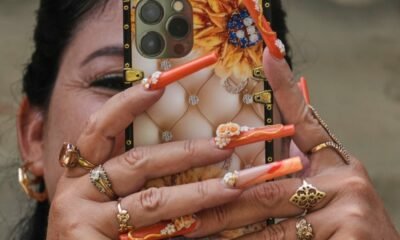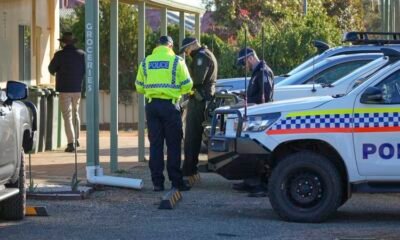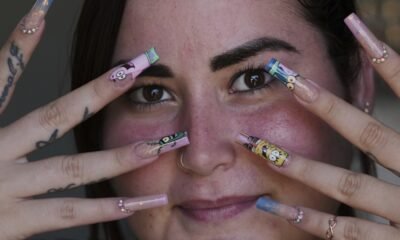Paris
CNN
—
Over 150 years ago, rich women from all over the world came to 7 Rue de La Paix in Paris to be dressed by couturier Charles Frederick Worth, whose eponymous fashion house, founded in 1858, continued through three generations after his death in 1895. Widely credited by historians as the “father of haute couture,” Worth was the first designer to be known by his name, and not by who wore his clothes. He gained international acclaim and shaped the way fashion was marketed and worn. His legacy is now being documented in a new exhibition, “Worth: Inventing Haute Couture,” running until September 7 at the Petit Palais art museum in Paris.
A collaboration between the Petit Palais and the Palais Galliera, it is the first retrospective of the House of Worth staged in France, and the second only in the world — the last being over 60 years ago at the Brooklyn Museum in New York — and coincides with Worth’s 200th birthday this year. The Worth family’s close ties to artists during the 19th and 20th centuries and the Petit Palais’s “flamboyant architectural testament to this period,” said the museum’s director and chief curator Annick Lemoine, made Petit Palais “the perfect setting,” she told CNN ahead of the show’s opening.
The exhibition encompasses the house’s work from its inception to the 1920s — when famous actresses and singers, such as Sarah Bernhardt, Sophie Croizette and Nellie Melba, wore its clothes on-stage and off. Also on show are art and design items that belonged to the Worth family, including a black lacquer screen by French Art Deco artist and designer Jean Dunand and a series of nude photographs of Worth’s great-grandson Jean-Charles taken by American visual artist Man Ray.

Fragrance has also been incorporated in the exhibition, where visitors can smell a recreation of “Je Reviens,” a light powdery, floral scent by Worth. While Osmothèque, the world’s largest scent archive, based in Versailles, remade the fragrance for the exhibition, the scent itself was relaunched in 2005 by perfumer Maurice Blanchet and continues to be sold. Original Worth perfume bottles designed by René Lalique are also on display.
As some of the garments are too fragile, the show will not travel internationally, said Raphaële Martin-Pigalle, chief heritage curator of the Petit Palais’s modern paintings department.
Worth was born in England in 1825, where he trained with two textile merchants before heading across the Channel to work for Maison Gagelin, a clothing store in Paris, as a salesperson and dressmaker, eventually working up to becoming a partner. He then went on to establish his fashion house — initially called Worth and Bobergh, named after himself and business partner Otto Bobergh, a Swede.

Worth decided what women would wear, not by creating new silhouettes, but by changing the business model. Today, haute couture fashion shows take place twice a year as designers present the latest styles for clients to pick from. But this wasn’t always the way.
Before Worth, “couturiers didn’t have much latitude to invent looks,” said Sophie Grossiord, Palais Galliera’s interim director and general curator in charge of the collections from the first half of the 20th century. At the time, aristocratic women brought fabric and ideas of what they wanted to wear to couturiers, who would then produce those garments. But that wasn’t how Worth operated; instead, he designed looks that customers, if interested, could buy — subsequently turning the role of the designer, as someone who would merely serve the wealthy, to one of authority whom clients would look up to and follow guidance on how to dress.
“Women come to see me to ask for my ideas, not to follow theirs,” Worth notably said to Blackwood’s Edinburgh Magazine, a literary and political periodical, in 1858.
Worth “didn’t necessarily agree with what his clients wanted,” said Grossiord. At Worth and Bobergh, the clothes were already made, but embellishments — like woven borders, lace and fake flowers — could be added. The clothing could also be modular, with interchangeable parts such as different sleeve lengths for different times of the day, as seen in the “transformation dress” from the late 1860s.
The demand for Worth’s clothes was great: During the Second French Empire from 1852 to 1870, elaborate costume balls were all the rage — and paintings shown in the Petit Palais exhibition, including Jean Béraud’s “Une Soirée” (1878), depict Worth gowns at these events.
Worth’s costumes ranged from the avant-garde — like an umbrella costume from 1925, which looks like a cross between waders and an upside-down closed umbrella — to those which referenced history, like the dress made for Madame Charles-Pierre Pecoul for Princess Sagan’s ball around 1893, modeled after a painting of the infant Margaret Theresa of Spain. The house only ever made one suit for a man outside of the family: It was for the Duke of Marlborough and the most expensive costume made.

Supporters of Worth included Empress Eugénie, wife of Napoleon III and one of the leading trendsetters in Europe, who learned of Worth through her close friend, Princess Pauline von Metternich, and Valérie Feuillet (who was married to the writer Octave Feuillet), according to the show’s catalogue. As the French Empress threw her support behind Worth, he soon became the go-to name in fashion. “Worth is an authority,” French news magazine Le Monde Illustré wrote in 1868, describing him as “the absolute power in the world’s royalties.”
Worth’s atelier doubled from over 500 workers in the 1860s to over 1,000 in the ’70s, as he sought to cater to clients, several of whom were European royals from across France, Russia, Austria, Spain, Portugal and Sweden. Though, a majority of Worth’s business came from customers further afield, in India, Japan, Hawaii and Egypt. American high society, which included the Astor, Morgan and Vanderbilt families, also provided a large source of income — as was emphasized towards the exhibition finale, where scenes from HBO TV series “The Gilded Age” are projected. (HBO and CNN share the same parent company, Warner Bros. Discovery.)
As the Second Empire came to an end, so did Worth and Bobergh’s partnership — the company’s founding documents say it was intended to last 12 years. There is little known about Bobergh, so the exact reasons behind his departure are unknown. But Worth carried on, with the help of his wife, Marie, and later, his sons Gaston and Jean-Philippe.
With the shift in French regime to the Third Republic, tastes changed — in fashion, crinolines were out, bustles were in. Worth adapted by bringing down the flamboyancy of his clothes. But another challenge soon emerged: In the 1890s, the US significantly raised its customs duties, creating the most consequential tariff of the 19th century and Worth’s clothes became extremely costly to export. That created an opportunity for copycats in the American market to create similar-looking pieces, for cheaper prices. “The copying phenomenon was a problem for all couturiers,” Grossiord said, noting: “the copiers pillaged their ideas.”
In response, in 1868 Worth founded the Chambre Syndicale de la Haute Couture (it later became the Fédération de la Haute Couture et de la Mode and remains France’s governing fashion body) to protect the designs of French couture houses from copying and to promote the status of Paris as the fashion capital of the world.
Worth also established practices that are now regarded as standard in fashion, such as using live models (Worth’s wife, Marie, was his first model) and runway shows to present new collections. Worth also photographed each of his looks and registered it by name or number. All of these were efforts to reduce the forgery of his designs.

“There was a clientele we can’t even imagine,” Grossiord said, noting that while Worth’s own order books have largely disappeared, some records still exist from the early days of Louis Vuitton (whose trunks were used to transport Worth’s clothes) and Cartier (with whom the Worth family had two marriages). Among some of the most sumptuous dresses that feature in the Paris exhibition include those belonging to Countess Élisabeth Greffulhe, who was the inspiration of the Duchess of Guermantes, a character from Marcel Proust’s literary masterpiece “À la Recherche du Temps Perdu.”
Worth himself was such a grand figure that he, too, has been immortalized in fiction: In his book “La Curée” (The Kill), French novelist Émile Zola based the character Worms on Worth, calling him, “the genius tailor, before whom the Second Empire’s rulers took to their knees.” Over 100 years later, thousands continue to marvel at Worth’s clothes. His legacy lives on.


































